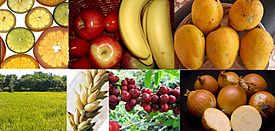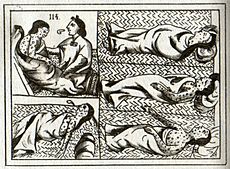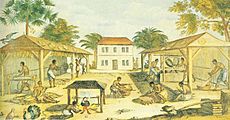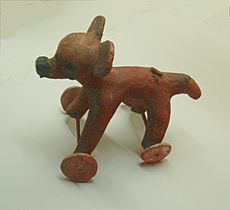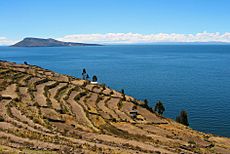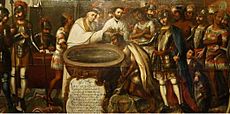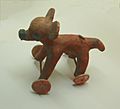Columbian exchange facts for kids
The Columbian exchange, also known as the Columbian interchange, was a huge movement of plants, animals, goods, ideas, and even diseases between the New World (the Americas) and the Old World (Europe, Asia, and Africa). This exchange started in the late 1400s and continued for centuries. It is named after the explorer Christopher Columbus, who made his first voyage in 1492.
Some of these exchanges were planned, like bringing new crops. Others were accidental, like diseases. Sadly, diseases from the Old World caused a huge drop in the number of Native Americans. Their population fell by 80 to 95 percent after the 15th century. This was especially bad in the Caribbean.
The movement of people also changed cultures in both parts of the world. Many Europeans moved to the Americas. Even more Africans were brought to the Americas as slaves. This changed the populations and cultures of the Americas forever.
This new connection between continents brought many new crops and livestock. This helped food production grow and led to more people living in the Old World. Crops from the Americas, like maize (corn), potatoes, tomatoes, and tobacco, became important all over the world. Old World crops like rice, wheat, and sugar cane became important in the Americas. Also, a lot of silver from the Americas was sent around the world. It became a main metal for coins, especially in China.
The term "Columbian exchange" was first used in 1972. It was created by an American historian named Alfred W. Crosby in his book The Columbian Exchange. Other historians and journalists quickly started using it too.
Contents
What is the Columbian Exchange?
In 1972, Alfred W. Crosby, a historian, wrote a book called The Columbian Exchange. He focused on how living things and cultures moved between the Old World and the New World. He studied what happened after Christopher Columbus's trips. This included how crops and plants from the Americas spread to the Old World. This greatly changed farming in both areas. His work helped people understand how today's different natural environments came to be because of these transfers.
The term became very popular. Crosby later wrote another book, Ecological Imperialism: The Biological Expansion of Europe, 900–1900. Another author, Charles C. Mann, wrote 1493, which added more to Crosby's ideas.
How did the exchange begin?
Scientists believe that humans first came to the Americas from Siberia thousands of years ago. There is not much proof of other contacts between the Old World and New World before Columbus. The first people in the Americas brought dogs and possibly a type of container called a calabash.
The Norsemen (Vikings) visited and lived briefly in Greenland and Newfoundland around the 10th and 11th centuries. However, their visits did not have a lasting impact on the Americas. Some scientists think that Polynesians might have met people in South America around 1200. This might be why Polynesians started growing sweet potatoes, which came from the Americas.
But the real Columbian exchange, which caused huge changes, began with Christopher Columbus's first trip to the Americas in 1492.
How did diseases spread?
One of the first parts of the Columbian exchange was the spread of diseases. Sadly, diseases from the Old World were much more deadly for people in the Americas. Native Americans had never been exposed to European and African diseases. This meant they had little or no protection against them.
For example, a flu epidemic in 1493 killed many of the Taino people in the Caribbean islands. The island of Hispaniola likely had at least 500,000 people before Columbus. By 1526, fewer than 500 were left. Spanish actions also contributed to this terrible decline.
In 1518, smallpox appeared in the Americas for the first time. It became the deadliest European disease. In 1520, during a war with the Spanish leader Hernán Cortés, about 40% of the 200,000 people in the Aztec capital, Tenochtitlan, died from smallpox. Epidemics, possibly smallpox, also wiped out many people in the Inca Empire before the Spanish arrived.
The population of Mexico dropped from about 20 million to just over a million in the 1500s because of European diseases and Spanish actions. In Peru, the number of people fell from about 9 million to 600,000 by 1620. Experts estimate that 80–95% of Native Americans died from epidemics within 100–150 years after 1492. Some places lost everyone. The most dangerous Old World diseases were smallpox, measles, whooping cough, chicken pox, bubonic plague, typhus, and malaria.
Why were Africans enslaved?
The Atlantic slave trade was the forced movement of about 11.7 million Africans to the Americas. This happened between the 1500s and 1800s. Most came from West Africa. This number was much higher than the 3.4 million Europeans who moved to the Americas during the same time.
African slaves were brought to the Americas because so many Native Americans had died from diseases. European colonists needed people to work. Another reason was the growing of special crops like sugar cane. These crops grew well in the new lands and were very popular. Africans had stronger protection against Old World diseases than Native Americans. This meant they were less likely to die from illness. The journey of enslaved Africans from Africa to America is known as the "middle passage".
Enslaved Africans helped create a new African-American culture in the Americas. They worked in many jobs, both skilled and unskilled. For example, some were skilled craftspeople. Others managed small businesses. Their children and grandchildren slowly developed a new identity, combining parts of many African tribes and European cultures. Today, descendants of African slaves make up most of the population in some Caribbean countries, like Haiti and Jamaica. They are also a large group in many other American countries.
Some enslaved people resisted slavery. They ran away into rainforests and fought the colonists. They also kept their cultural traditions alive as a way of resisting. Women had a big role in passing on their culture to future generations because they raised the children.
A movement to end slavery, called abolitionism, grew in Europe and the Americas in the 1700s. Their efforts eventually led to slavery being ended. This happened in the British Empire in 1833, the United States in 1865, and Brazil in 1888.
The importance of silver
The Americas produced 80% or more of the world's silver in the 1500s and 1600s. Most of it came from Potosí in Bolivia and also from Mexico. The city of Manila in the Philippines was founded in 1571. Its purpose was to help trade silver from the Americas to China. In return, China sent silk, porcelain, and other fancy goods. Some experts call this the "origin of world trade."
China had the world's largest economy. In the 1570s, China started using silver as its main money. China didn't produce much silver itself. So, trade meant huge amounts of silver went into China to pay for Chinese products that other countries wanted. Silver reached Manila either through Europe and around Africa, or across the Pacific Ocean on Spanish ships called galleons from Mexico. From Manila, the silver went to China on Portuguese and Dutch ships. Silver was also secretly sent from Potosi to Buenos Aires, Argentina, to pay for African slaves brought to the Americas.
All this silver made Spain and China very rich. But it also caused prices to go up, and the value of silver went down. For example, in China in the 1500s, six ounces of silver were worth one ounce of gold. By 1635, it took 13 ounces of silver to equal one ounce of gold. Taxes in both countries were based on the weight of silver, not its changing value. This drop in silver's value might have helped cause the fall of the Ming dynasty in China in 1644.
Similarly, silver from the Americas helped Spain pay for its wars in Europe. When the value of silver dropped, Spain struggled to keep its worldwide empire. It also pulled back from its aggressive plans in Europe after 1650.
The wheel in the Americas
Before Europeans arrived, people in the Americas did not use wheels on a large scale. However, many small wheeled objects, like children's toys, have been found in Mexican ancient sites. Some of these toys are from around 1500 BC.
Some people believe that the main reason wheels weren't used for big things in the Americas was a lack of large animals that could pull wheeled carts. The closest animal to cattle in the Americas was the American bison. But bison are hard to tame and were never domesticated by Native Americans. Several types of horses lived in the Americas until about 12,000 years ago, but they died out. The only large animal tamed in the Americas was the llama. Llamas were used to carry things, but they weren't strong enough to pull wheeled vehicles. Also, llamas were mostly found in the Andes mountains.
People in Mesoamerica (like the Maya) never developed things like the wheelbarrow or the potter's wheel. Even though wheels were in toys, they were never used for practical purposes in Mesoamerica before the 1500s.
What were the effects of the exchange?
New crops around the world
The Columbian exchange led to many plants from the Americas spreading globally. These included potatoes, maize (corn), tomatoes, and tobacco. Before 1500, potatoes only grew in South America. By the 1700s, they were grown and eaten widely in Europe. They also became important crops in India and North America. Potatoes have a lot of calories. They became a key food in much of Europe. They helped the population in Europe, Asia, and Africa grow by an estimated 25% between 1700 and 1900. Many European rulers, like Frederick the Great of Prussia, encouraged growing potatoes. Experts say that potatoes, even without some vitamins, improved diets and helped populations and cities grow.
Maize and cassava were brought to Africa by the Portuguese in the 1500s. They slowly replaced other important food crops like sorghum and millet. Spanish settlers also brought new main crops like maize and sweet potatoes to Asia. This helped Asian populations grow. Overall, potatoes and maize gave people in Europe and Asia more calories and better nutrition. This allowed for more varied and plentiful food. While maize was popular, cassava was also in high demand in the Old World. These crops can have negative effects if eaten too much, but they were still very important for human nutrition.
Tomatoes came to Europe from the Americas through Spain. At first, people in Italy liked them mostly for their beauty. But starting in the 1800s, tomato sauce became a key part of Italian cooking. Experts say that the discovery of the Americas brought the Old World not only new plants but also good soil for growing valuable crops like sugarcane and coffee. Sugar was very important because it had many calories and was cheap. It was also used a lot in cooking. Coffee (brought to the Americas around 1720) from Africa and the Middle East, and sugarcane (from India) became major crops grown on large farms in Latin America.
Chili peppers and potatoes from South America were brought to India by the Portuguese. They are now a big part of Indian food. Chili peppers helped create many famous dishes, like Korean kimchi and Indian curry. Chili peppers contain capsaicin, which helps with digestion and is used in medicine.
When crops moved to new lands, their natural plant diseases often did not. This meant that for a while, the crops grew better in their new homes. This is called the "yield honeymoon." But as trade continued, these diseases also spread. Now, crop yields are going back to normal levels.
Experts also talk about chocolate and vanilla. The Spanish were the first to grow cacao (for chocolate) in 1590. At first, chocolate was expensive. But it helped people feel less tired and gave them energy. Vanilla pods, after being treated, gained a wonderful smell. This smell was then used in cooking and perfumes.
Rice cultivation
Rice became another widely grown crop during the Columbian exchange. As demand grew in the Americas, so did the knowledge of how to grow it. Two main types of rice were used: Oryza glaberrima from West Africa and Oryza sativa from Southeast Asia. European farmers in the Americas relied on the skills of enslaved Africans to grow both types of rice. Georgia, South Carolina, Cuba, and Puerto Rico were major areas for rice production. Enslaved Africans brought their knowledge of managing water, processing rice, and other farming methods. This knowledge helped rice become a main food in the Americas.
Fruits introduced
Citrus fruits and grapes were brought to the Americas from the Mediterranean region. At first, farmers had trouble growing these crops in the new climates. But by the late 1800s, they were grown more successfully.
Bananas were brought to the Americas in the 1500s by Portuguese sailors. They found bananas in West Africa while trading and participating in the slave trade. Bananas were not eaten much in the U.S. until large farms were set up in the Caribbean in the late 1800s.
The story of tomatoes
It took 300 years after tomatoes arrived in Europe for them to become a widely accepted food. Experts believe that wild tomatoes came from North to South America long before the Spanish arrived. This started tomato farming in different parts of the Americas.
Tomatoes, like potatoes and chili peppers, are part of the nightshade family. Some European nightshade plants can be harmful if eaten too much. So, doctors in the 1500s thought this native Mexican fruit might be poisonous. They worried it would cause "melancholic humours" (bad moods).
In 1544, an Italian doctor and plant expert, Pietro Andrea Mattioli, suggested that tomatoes might be edible. But there's no record of anyone eating them then. However, in 1592, a gardener in Spain wrote that "it is said [tomatoes] are good for sauces." Despite this, tomatoes remained mostly ornamental plants, grown for their beauty, not for food.
On October 31, 1548, tomatoes got their first European name. A servant of Cosimo I de' Medici wrote that a basket of pomi d'oro ("golden apples") had arrived safely. In early years, tomatoes were mainly grown for decoration in Italy. For example, a noble from Florence wrote that they "were to be sought only for their beauty."
Experts say tomatoes are very healthy, with important vitamins like C and A. Even though they have few calories, tomatoes are a regular food for many Westerners. The first Italian cookbook to include tomato sauce was Lo Scalco alla Moderna, published in 1692. Tomato sauce with pasta first appeared in a cookbook in 1790. Today, about 32,000 acres of tomatoes are grown in Italy.
One challenge with tomatoes was storing them. In hot weather, they spoiled in just a few days. Canning solved this problem, allowing tomatoes to be stored for months. At first, canning was expensive, but with machines, tomatoes became available to everyone. Medical studies show that canned tomatoes contain a useful antioxidant called lycopene, which can lower the risk of serious diseases.
New animals for new lands
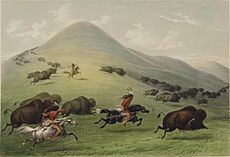
At first, the exchange of animals mostly went one way: from Europe to the Americas. This is because Europe and Asia had already tamed many more animals. Horses, donkeys, mules, pigs, cattle, sheep, goats, chickens, large dogs, cats, and bees were quickly adopted by Native peoples. They used them for travel, food, and other purposes.
Horses were one of the first European animals brought to the Americas. They changed the lives of many Native American tribes. For example, tribes in the mountains started living a nomadic lifestyle, hunting bison on horseback. They largely stopped farming. Horse culture slowly spread among the Great Plains Indians. Existing Plains tribes expanded their lands with horses. Horses became so valuable that the size of a horse herd showed how rich someone was. (This transfer brought horses back to the Americas, as horses had died out there before modern horses developed in Europe and Asia.)
While people in Mesoamerica (like the Maya) already kept bees for wax and honey, European bees (Apis mellifera) were introduced. These bees were more productive and made honey that was easier to get from beehives. They became an important part of farming.
The introduction of European animals did not always have good effects. In the Caribbean, many European animals ate native plants and small animals. This changed the natural environment. If the animals roamed freely, they often damaged the small farms of the native peoples.
The Mapuche people in Araucanía quickly adopted horses from the Spanish. This improved their fighting skills as they fought the Arauco War against Spanish settlers. Before the Spanish arrived, the Mapuche mainly kept llamas. When sheep were introduced, they competed with llamas. By the late 1700s, sheep greatly outnumbered llamas. In the Chiloé Archipelago, the Spanish brought pigs, which did very well. They could eat the many shellfish and algae found during low tides.
In the other direction, the turkey, guinea pig, and Muscovy duck were animals from the Americas that were brought to Europe.
New medicines and diseases
European explorers in tropical areas were helped by the discovery of quinine in the Americas. Quinine was the first effective treatment for malaria. Scientists found that cinchona trees from the Andes mountains could be processed to get quinine from their bark. Europeans suffered greatly from malaria. Some native populations had developed some protection against it. In Africa, resistance to malaria is linked to genetic changes in people from sub-Saharan Africa, which can cause sickle-cell disease. The fact that sub-Saharan Africans were more resistant to malaria in the southern United States and the Caribbean greatly influenced the use of African slaves in those regions.
Similarly, yellow fever is thought to have come to the Americas from Africa through the Atlantic slave trade. Because it was common in Africa, many people there had developed immunity. Europeans suffered more deaths from yellow fever than people of African descent. Many epidemics swept through the colonies starting in the 1600s and continuing into the late 1800s. The disease caused many deaths in the Caribbean when sugar plantations relied heavily on slave labor. Replacing native forests with sugar farms and factories helped the disease spread. This was because it reduced the number of natural mosquito predators. How yellow fever spread was unknown until 1881. That's when Carlos Finlay suggested that mosquitoes, specifically female Aedes aegypti mosquitoes, spread the disease.
Cultural changes
The movement of people between the New and Old Worlds also led to many cultural exchanges. For example, some experts say that a "clash of cultures" began in the Atlantic around 1500. This meant European ideas were transferred to native cultures. This included the idea of private property, where land is owned by individuals. Many native peoples had viewed land as belonging to the community. Other ideas included monogamy (being married to one person), the roles of women and children in society, and different ideas about work, including slavery. (Though slavery was already practiced by some native peoples and was widely introduced by Europeans.)
When European settlers arrived in Virginia, they saw lands without fences. They thought the land was empty and available for them to take. They were looking for economic opportunities and places to build homes. However, they met the Powhatan people, who were already established farmers. The Powhatan farmers had scattered their plots within larger cleared areas. These larger areas were communal places for growing useful plants. Europeans saw fences as a sign of civilization. So, they began changing the land to fit their own ideas.
Tobacco was a plant from the Americas. It became a luxury good that spread as part of the Columbian exchange. The tobacco trade increased the demand for free labor (slavery) and spread tobacco worldwide. A Spanish doctor in the 1500s noted that "The black people that have gone from these parts to the Indies, have taken up the same manner and use of tobacco that the Indians have." As Europeans traveled, they took tobacco practices with them. Demand for tobacco grew because of these cultural exchanges. Tobacco was used in the Old World as medicine and even money. In the New World, it was part of religious customs. Tobacco was very popular until the 1950s, when its harmful effects on the human body were discovered. Even now, many people continue to die from too much tobacco use.
One of the clearest cultural changes was in religion. Spreading Catholicism, with its European values, was a main goal of Spanish and Portuguese colonization. Europeans often tried to achieve this by stopping native languages, cultures, and religions. In British America, Protestant missionaries converted many Native Americans to Protestantism. French colonies also had a strong religious goal. Some early explorers, like Jacques Marquette, were also Catholic priests. Over time, because Europeans had better technology and immunity to diseases, native religions declined after Europeans settled in the Americas.
While the Mapuche people did adopt horses, sheep, and wheat, they generally didn't adopt much Spanish technology. This has been seen as a way of cultural resistance.
According to historian Caroline Dodds Pennock, Native Americans are often seen as just receiving changes from across the Atlantic. But thousands of Native Americans actually crossed the ocean during the 1500s, some by choice.
Images for kids
-
A figurine featuring the New World's independently invented wheel. Among the places where wheeled toys were found, Mesoamerica is the only one where the wheel was never put to practical use before the 16th century.
See also
 In Spanish: Intercambio colombino para niños
In Spanish: Intercambio colombino para niños
- Arab Agricultural Revolution
- First contact (anthropology)
- Great American Interchange
- List of food plants native to the Americas
- Global silver trade from the 16th to 19th centuries



